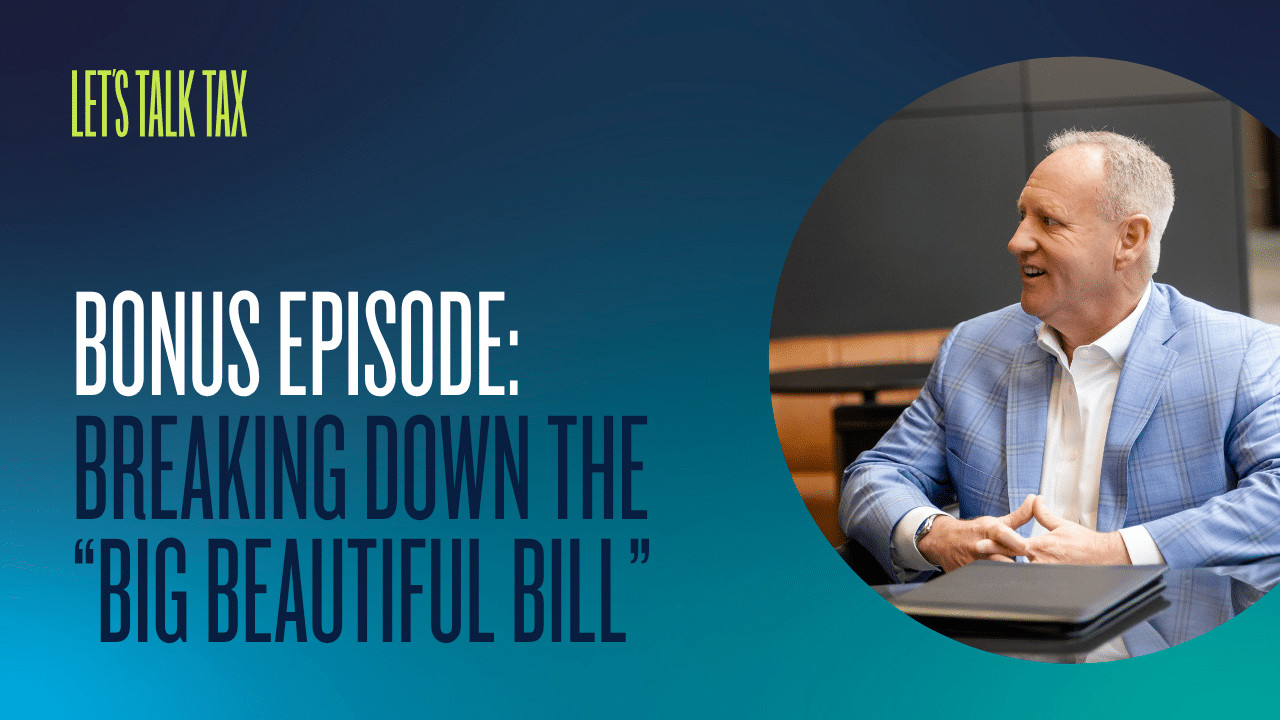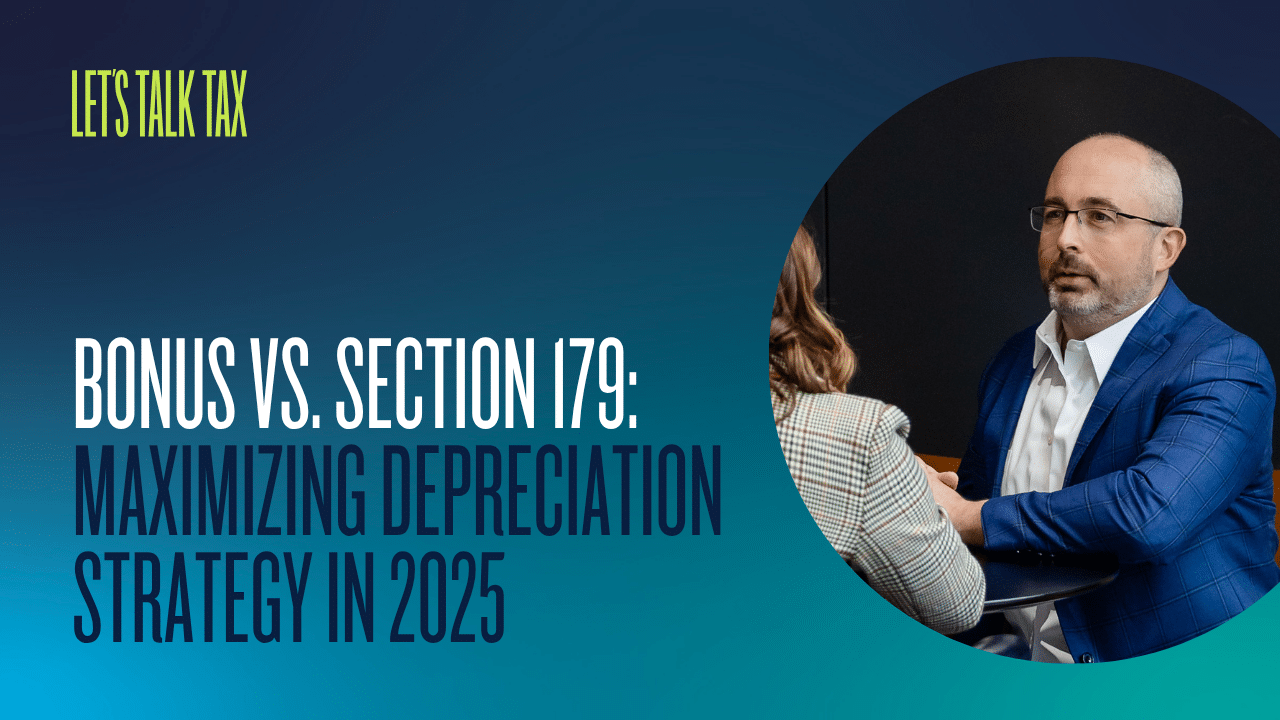With the passing of the “Big Beautiful Bill,” bonus depreciation is back at 100%—permanently. However, the binding contract rule adds a level of complexity that advisors and property owners must understand.
With the “Big Beautiful Bill” now enacted into law, sweeping tax changes are officially underway—impacting provisions critical to year-end planning, entity strategy, and client advisory services. CPAs and tax professionals must act quickly to understand how these updates affect their clients across industries.
Just days after the latest tax legislation—informally dubbed the “Big Beautiful Bill”—was signed into law, significant planning opportunities are already emerging. With provisions impacting bonus depreciation, Section 179 expensing, and the long-awaited fix to Section 174, CPA firms should begin evaluating client strategies now to ensure compliance and maximize benefit.
Host Dave McGuire and Jerry Hammel, CPA, break down the newly signed “Big Beautiful Bill”—including the return of 100% bonus depreciation and critical updates to Section 174—and what CPAs should do now to prepare their clients.
Host Tim LeMasters is joined by Dave McGuire to unpack the complexities of bonus depreciation and Section 179 expensing.
Explore the Senate’s proposed fixes to Section 174, permanent bonus depreciation, and what these changes could mean for tax planning in 2025 and beyond.
With fixed assets among the largest line items on a company’s books, even small errors in depreciation or classification can result in significant tax and financial consequences.
David McGuire and Justin Gephart join Evan Ross on the Real Estate Tax Playbook to discuss property tax appeals, valuation strategies, and upcoming tax legislation.
Hosts Tim LeMasters and Justin Gephart sit down with Property Tax Consultant Tanner Cox to explore how shifting occupancy trends are creating new opportunities—and challenges—for property tax appeals.
On May 22, the U.S. House of Representatives passed a wide-reaching bill titled the “One Big, Beautiful Bill Act” featuring broad tax reform.
How the New Binding Contract Rule Affects Property Purchases and Self-Constructed Properties
With the passing of the “Big Beautiful Bill,” bonus depreciation is back at 100%—permanently. This is a major win for real estate investors and businesses planning large capital expenditures. However, a new detail buried in the law—the binding contract rule—adds a level of complexity that advisors and property owners must understand.
The Binding Contract Rule: What It Means
The binding contract rule determines which assets qualify for the 100% bonus depreciation provisions, and it applies differently depending on whether the property is purchased or self-constructed.
For property purchases, the rule is relatively straightforward. In order to qualify for 100% bonus depreciation under the new law:
- The asset must be placed in service after January 19, 2025
- The taxpayer must not have been under a binding contract to purchase that property before that same date
A binding contract is defined as an agreement that is legally enforceable under state law and cannot be canceled without a significant penalty. This means that if you enter into a purchase agreement before January 19, 2025—even if you close later that year—you may be only eligible for 40% bonus depreciation under the updated rules. In contrast, a similar property purchased under a contract signed on or after January 20, 2025, could qualify for 100% bonus depreciation. This seemingly minor timing detail can have a significant impact on your depreciation schedule and upfront tax benefits.
For self-constructed property, the situation is more nuanced. The IRS has long applied different timing rules for assets built by the taxpayer rather than purchased from a third party. Under the new law, the rule hinges on when construction meaningfully begins, not when a purchase contract is signed. This could include:
- Entering into binding contracts for major materials or labor
- Beginning physical work
- Taking other substantial steps toward project completion
If any of those steps occur before January 19, 2025, the project might not qualify for 100% bonus depreciation—even if it isn’t completed until much later. This is where the 10% rule may come into play. If 10% or more of a project’s total expected costs were incurred prior to January 19, 2025, the IRS may consider the project “commenced” and therefore subject to the old bonus depreciation rules.
Binding Contract Example
This can get even more confusing. The IRS allows for an election to treat components separately as it relates to bonus depreciation resulting in mixed treatment within the same project. In some projects some components qualify for bonus depreciation and others do not, depending on when costs were incurred. An example of this would be if the foundations, framing, and land improvements are 60% completed before January 20, 2025, qualifying assets within these components would only qualify for 40% bonus depreciation. But within the same contract, if the remaining components, such as electrical, plumbing, HVAC, and interiors, are only 8% completed before January 20, 2025, the qualifying assets within these components would qualify for 100% bonus depreciation. As such, proper cost tracking and documentation is crucial.
When Bonus Depreciation Isn’t an Option: Consider Section 179
In situations where 100% bonus depreciation is off the table due to timing or structural limitations, Section 179 expensing may serve as a viable alternative. Section 179 allows taxpayers to deduct the full cost of qualifying property placed in service, but without binding contract limitations.
Pros:
- More flexibility as it is based on the placed-in-service date
- Limits for 179 were increased under the new law
Considerations:
- Annual deduction caps, business income limitations apply
- Entity structure (pass-through entity vs. C corp.) impacts treatment
Advisors should evaluate Section 179 as an alternative when bonus depreciation eligibility is limited by timing or structure. Understanding when to use Section 179 versus bonus depreciation will be a key part of strategic tax planning moving forward.
The Bonus Depreciation Takeaway
If you’re involved in real estate investment, construction, or capital planning, now is the time to assess your projects and timelines. McGuire Sponsel’s Fixed Asset Services team is ready to help you review contracts and navigate the binding contract rule to ensure you don’t miss out on valuable depreciation opportunities and make a substantial difference in your tax position.
Mike Hidde serves as a Senior Manager in McGuire Sponsel’s Fixed Assets practice, where he oversees the day-to-day operations of the firm’s cost segregation projects. He ensures that site visits and deliverables move efficiently through each stage, maintaining both accuracy and timely turnaround for clients.
Recent Resources
-
Alliance NetworkJuly 10, 2025
2025 Tax Reform: Decoding the “Big Beautiful Bill”
by Dave McGuireWith the “Big Beautiful Bill” now enacted into law, sweeping tax changes are officially underway—impacting provisions critical to year-end planning,...
-
Alliance NetworkJuly 9, 2025
‘Big Beautiful Bill’ Tax Legislation Brings Immediate Planning Opportunities for CPA Firms
by Jerry Hammel, CPAJust days after the latest tax legislation—informally dubbed the “Big Beautiful Bill”—was signed into law, significant planning opportunities are already...
-
Alliance NetworkJuly 8, 2025
Bonus Episode: Breaking Down the “Big Beautiful Bill”
by Dave McGuire and Jerry Hammel, CPAHost Dave McGuire and Jerry Hammel, CPA, break down the newly signed “Big Beautiful Bill”—including the return of 100% bonus...
-
Fixed Asset ServicesJune 23, 2025
Bonus vs. Section 179: Maximizing Depreciation Strategy in 2025
by Tim LeMasters & Dave McGuireHost Tim LeMasters is joined by Dave McGuire to unpack the complexities of bonus depreciation and Section 179 expensing.





